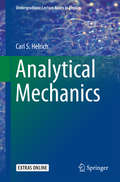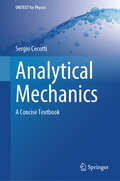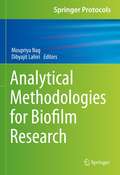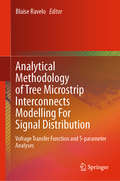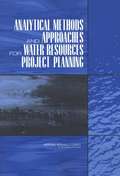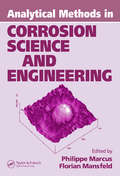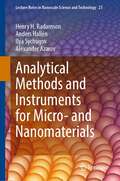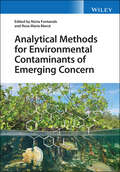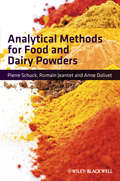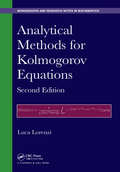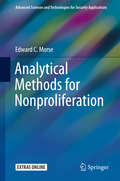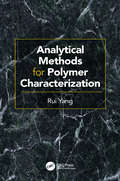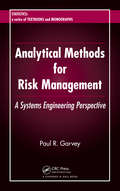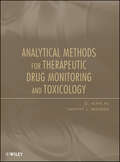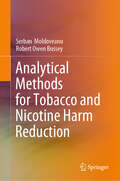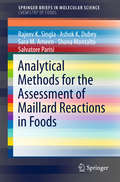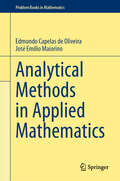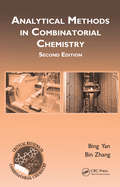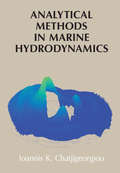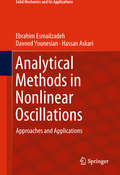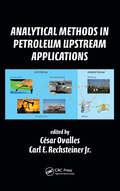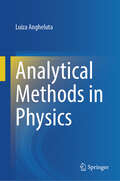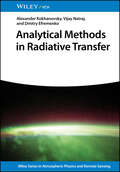- Table View
- List View
Analytical Mechanics (Undergraduate Lecture Notes in Physics)
by Carl S. HelrichThis advanced undergraduate textbook begins with the Lagrangian formulation of Analytical Mechanics and then passes directly to the Hamiltonian formulation and the canonical equations, with constraints incorporated through Lagrange multipliers. Hamilton's Principle and the canonical equations remain the basis of the remainder of the text. Topics considered for applications include small oscillations, motion in electric and magnetic fields, and rigid body dynamics. The Hamilton-Jacobi approach is developed with special attention to the canonical transformation in order to provide a smooth and logical transition into the study of complex and chaotic systems. Finally the text has a careful treatment of relativistic mechanics and the requirement of Lorentz invariance. The text is enriched with an outline of the history of mechanics, which particularly outlines the importance of the work of Euler, Lagrange, Hamilton and Jacobi. Numerous exercises with solutions support the exceptionally clear and concise treatment of Analytical Mechanics.
Analytical Mechanics: A Concise Textbook (UNITEXT for Physics)
by Sergio CecottiThis textbook is based on the author's lecture notes held at Qiuzhen College, Tsinghua University, Beijing, renowned for its rapid scientific growth of its excellent students. The book offers a remarkable combination of characteristics that are both exceptional and seemingly contradictory. It is designed to be entirely self-contained, starting from the basics and building a strong foundation in geometric and algebraic tools. Simultaneously, topics are infused with mathematical elegance and profundity, employing contemporary language and techniques. From a physicist's perspective, the content delves deeply into the physical aspects, emphasizing the underlying principles. This book bridges the gap between students and cutting-edge research, with a special focus on symplectic geometry, integrability, and recent developments in the field. It is designed to engage and captivate the reader. A conscious selection of topics ensures a more relevant and contemporary approach compared to traditional textbooks. The book addresses common misconceptions, offering clarity and precision. In its quest for brevity, this book is tailored for a one-semester course, offering a comprehensive and concise resource. The author's dedication is evident throughout this volume, encapsulating these goals within roughly 300 pages.
Analytical Method Development and Validation
by Ira S. Krull Michael SwartzDescribes analytical methods development, optimization and validation, and provides examples of successful methods development and validation in high-performance liquid chromatography (HPLC) areas. The text presents an overview of Food and Drug Administration (FDA)/International Conference on Harmonization (ICH) regulatory guidelines, compliance with validation requirements for regulatory agencies, and methods validation criteria stipulated by the US Pharmacopia, FDA and ICH.
Analytical Methodologies for Biofilm Research (Springer Protocols Handbooks)
by Moupriya Nag Dibyajit LahiriThe book provides the readers of various discipline an easy understanding of the latest biophysical techniques pertaining to microbiology. Biofilm associated chronic infection is a major health problem and a serious concern to doctors, scientists and other health workers as it develops antibiotic and multi-drug resistance. This book describes various protocols utilized in the detection of the biofilm. The book has been divided into six sub sections which provides pertinent information about the various biophysical techniques and instruments that are used for detecting and analyzing the biofilm formation upon biotic and abiotic surfaces. The readers will be able to identify the techniques that can best cater information to solve the problem at hand. This book attempts to compile the latest information on the recent advances in the various functional aspects of microbial biofilms, their pathogenesis, present day treatments as well as detection strategies.This book is meant for researchers in the field of microbiology and interested in understanding microbial pathogenesis, quorum sensing and biofilm formation.
Analytical Methodology of Tree Microstrip Interconnects Modelling For Signal Distribution: Voltage Transfer Function and S-parameter Analyses
by Blaise RaveloThis book focuses on the modelling methodology of microstrip interconnects, discussing various structures of single-input multiple-output (SIMO) tree interconnects for signal integrity (SI) engineering. Further, it describes lumped and distributed transmission line elements based on single-input single-output (SIMO) models of symmetric and asymmetric trees, and investigates more complicated phenomenon, such as interbranch coupling. The modelling approaches are based on the analytical methods using the Z-, Y- and T-matrices. The established method enables the S-parameters and voltage transfer function of SIMO tree to be determined. Providing illustrative results with frequency and time domain analyses for each tree interconnect structure, the book is a valuable resource for researchers, engineers, and graduate students in fields of analogue, RF/microwave, digital and mixed circuit design, SI and manufacturing engineering.
Analytical Methods And Approaches For Water Resources Project Planning
by Panel On Methods Techniques of Project AnalysisInformation on Analytical Methods And Approaches For Water Resources Project Planning
Analytical Methods In Corrosion Science and Engineering (Corrosion Technology)
by Philippe Marcus Florian MansfeldDamage from corrosion costs billions of dollars per year. Controlling corrosion requires a fundamental, in-depth understanding of the mechanisms and phenomena involved, and this understanding is best achieved through advanced analytical methods. The first book to treat both surface analytical and electrochemical techniques in a single reference, An
Analytical Methods and Instruments for Micro- and Nanomaterials (Lecture Notes in Nanoscale Science and Technology #23)
by Henry H. Radamson Anders Hallén Ilya Sychugov Alexander AzarovThis book describes analytical instruments widely used to characterize the nanostructured materials. It provides information about how to assess material quality, defects, the state of surfaces and interfaces, element distributions, strain, lattice distortion, and electro-optical properties of materials and devices. The information provided by this book can be used as a back-up for material processing, material design and debugging of device performance. The basic principles and methodology of each analysis technique is described in separate chapters, adding historic perspectives and recent developments. The data analysis, from simple to advanced level, is introduced by numerous examples, mostly taken from the authors' fields of research; semiconductor materials, metals and oxides. The book serves as a valuable guide for scientists and students working in materials science, physics, and engineering, who wish to become acquainted with the most important analytical techniques for nanomaterials.
Analytical Methods for Environmental Contaminants of Emerging Concern
by Núria Fontanals Rosa Maria MarcéAnalytical Methods for Environmental Contaminants of Emerging Concern Provides the analytical methodology required to detect different families of organic compounds of emerging concern (CECs) from environmental samples Most contaminants of emerging concern (CECs) —such as pharmaceuticals, personal care products, pesticides, sunscreens, perfluorinated compounds, and microplastics—have been present in the environment for years, yet some have only recently been identified, and many of these organic compounds remain unregulated. Analytical methods have been developed to determine the toxicity and risk of different families of CECs. Analytical Methods for Environmental Contaminants of Emerging Concern presents the methods currently available to determine families of organic CECs in environmental samples. Each section of the book is devoted to a particular family of CECs, covering different analytical methods supported by examples of both cutting-edge research and commonly used methods. An international panel of experts describes every step of the analytical procedures, including sample preparation, chromatographic separation coupled to mass spectrometry or other instrumental techniques. Specific requirements are linked to the properties of the contaminants and the sample matrix for each procedure presented. Throughout the book, in-depth case studies of analytical procedures for CEC extraction, separation, and determination are presented to help readers transfer the analytical methods to their laboratories. Provides detailed descriptions of various approaches for determining each group of CECs in environmental samples Covers different types of aqueous, solid, and atmospheric samples Includes up-to-date information on CEC properties, relevant legislation, reported or potential metabolites/transformation products, and environmental occurrence Addresses CECs such as novel psychoactive substances, artificial sweeteners, musk fragrances, disinfection byproducts, and microplastics Offers practical tips and advice on special care procedures to assist readers in CEC determination Analytical Methods for Environmental Contaminants of Emerging Concern is an essential reference and guide for advanced students and researchers in analytical chemistry and science, environmental science, forensic science, and specialized subjects related to analytical chemistry.
Analytical Methods for Food and Dairy Powders
by Anne Dolivet Romain Jeantet Pierre SchuckFood and dairy powders are created by dehydrating perishable produce, such as milk, eggs, fruit and meat, in order to extend their shelf life and stabilise them for storage or transport. These powders are in high demand for use as ingredients and as food products in their own right, and are of great economic importance to the food and dairy industry worldwide. Today, the ability to control food and dairy powder quality is a source of key competitive advantage. By varying the dehydration process design, and by controlling the technological and thermodynamic parameters during dehydration, it is possible for manufacturers to engineer the biochemical, microbiological and physical characteristics of the food powder to meet their specific product requirements.This book provides an overview of the existing, adapted or new techniques used to analyse safety and quality in modern food and dairy powders. Based on original research by the authors, the book uses 25 commercial dairy and non-dairy powders to illustrate a range of biochemical and physical methods used to evaluate and characterise powdered food products. Written from a practical perspective, each chapter focuses on a particular analytical technique, outlining the purpose, definition and principle of that method. The authors guide the reader through all of the instruments needed, the safety measures required, and the correct procedures to follow to ensure successful analysis. Instructions on accurate measurement and expression of results are included, and each chapter is richly illustrated with original data and worked examples.Analytical Methods for Food and Dairy Powders is a unique step-by-step handbook, which will be required reading for anyone involved in the development and manufacture of powdered food products. Food and dairy scientists based in industry will find it essential for new product development and improved quality control, while researchers in the laboratory will especially value the new techniques it comprises.
Analytical Methods for Heat Transfer and Fluid Flow Problems (Mathematical Engineering)
by Bernhard WeigandThis book describes useful analytical methods by applying them to real-world problems rather than solving the usual over-simplified classroom problems. The book demonstrates the applicability of analytical methods even for complex problems and guides the reader to a more intuitive understanding of approaches and solutions. Although the solution of Partial Differential Equations by numerical methods is the standard practice in industries, analytical methods are still important for the critical assessment of results derived from advanced computer simulations and the improvement of the underlying numerical techniques. Literature devoted to analytical methods, however, often focuses on theoretical and mathematical aspects and is therefore useless to most engineers. Analytical Methods for Heat Transfer and Fluid Flow Problems addresses engineers and engineering students. The second edition has been updated, the chapters on non-linear problems and on axial heat conduction problems were extended. And worked out examples were included.
Analytical Methods for Kolmogorov Equations (Chapman & Hall/CRC Monographs and Research Notes in Mathematics #25)
by Luca LorenziThe second edition of this book has a new title that more accurately reflects the table of contents. Over the past few years, many new results have been proven in the field of partial differential equations. This edition takes those new results into account, in particular the study of nonautonomous operators with unbounded coefficients, which has received great attention. Additionally, this edition is the first to use a unified approach to contain the new results in a singular place.
Analytical Methods for Nonproliferation (Advanced Sciences and Technologies for Security Applications)
by Edward C. MorseThis book is intended to be used as a textbook and research reference for the field of nuclear nonproliferation. The book is primarily technical and focussed on methods of detecting clandestine nuclear material that might be illicitly transported. The book also touches on nuclear forensics, i. e. methods for identification, attribution, and establishment of transport pathways for illicit nuclear material. Also covered are topics of methods used for arms control and treaty verification, and an assessment of technologies under development for all of the above. A description of the government and international agencies involved in nuclear terrorism prevention, nuclear safeguards, and arms control is also included.
Analytical Methods for Polymer Characterization
by Rui YangAnalytical Methods for Polymer Characterization presents a collection of methods for polymer analysis. Topics include chromatographic methods (gas chromatography, inverse gas chromatography, and pyrolysis gas chromatography), mass spectrometry, spectroscopic methods (ultraviolet-visible spectroscopy, infrared spectroscopy, Raman spectroscopy, and nuclear magnetic resonance), thermal analysis (differential scanning calorimetry and thermogravimetry), microscopy methods (scanning electron microscopy, transmission electron microscopy, and atomic force microscopy), and x-ray diffraction. The author also discusses mechanical and dynamic mechanical properties.
Analytical Methods for Risk Management: A Systems Engineering Perspective (Statistics: A Series of Textbooks and Monographs)
by Paul R. GarveyA Text on the Foundation Processes, Analytical Principles, and Implementation Practices of Engineering Risk ManagementDrawing from the author's many years of hands-on experience in the field, Analytical Methods for Risk Management: A Systems Engineering Perspectivepresents the foundation processes and analytical practices
Analytical Methods for Therapeutic Drug Monitoring and Toxicology
by Q. Alan Xu Timothy L. MaddenThis book is a compilation of summarized analytical methods designed to serve the needs of pharmacologists, toxicologists, and other allied health professionals involved the development, use, or monitoring of pharmaceuticals. The summaries are structured monographs on 511 different drug entities detailing 964 different analytical methods, providing the reader with a thorough description of method validation. These analytical methods include not only high performance liquid chromatography (HPLC), but also gas chromatography (GC), immunoassay, electrophoresis, ultra performance liquid chromatography (UPLC) coupled with UV (UPLC-UV) detection and mass spectrometry (UPLC-MS/MS). With more detailed and complete summaries than sketchy and abbreviated formats used in the other books, this book provides a thorough description of method validation and results, as well as the operating parameters.
Analytical Methods for Tobacco and Nicotine Harm Reduction
by Serban Moldoveanu Robert Owen BusseyThis book presents a critical review of the analytical methods used for the measurement of harmful and potentially harmful compounds (HPHC) in tobacco and nicotine-related products. In the first chapter of the book, a presentation of the main types of tobacco products is introduced, including cigarettes, cigars, cigarillos, little filter cigars, dissolvable tobacco products, hookah (shisha or waterpipe), nicotine gels, pipe tobacco products, roll your own, smokeless tobacco products, such as dip, snuff, snus, and chewing tobacco and E-Cigarettes, vapes, and other electronic nicotine delivery systems (ENDS). In the second and main part of the book, the analytical methods for the compounds in the established list from the U.S. Food and Drug Administration (FDA) of HPHC are discussed. For example, in cigarette smoke, specific discussions related to the analytical methods for nicotine, acetaldehyde, acrolein, acrylonitrile, aromatic amines, ammonia, benzene, benzo[a]pyrene, 1,3-butadiene, carbon monoxide, crotonaldehyde, formaldehyde, isoprene, TSNA&’s, and toluene are presented. Specific analytical methods for the analysis of HPHC in ENDS are also included. Various other analytical methods used for all the 93 HPHC in the established list by FDA for tobacco products and tobacco smoke are presented. The book will be useful to scientists working in the industry as well as students and researchers interested in the area.
Analytical Methods for the Assessment of Maillard Reactions in Foods (Springerbriefs In Molecular Science: Chemistry of Foods)
by Salvatore Parisi Sara M. Ameen Rajeev K. Singla Ashok K. Dubey Shana MontaltoThis Brief provides an overview of different analytical methods and techniques for the qualitative and quantitative evaluation of Maillard Reactions and their reaction products in foods during processing and storage. Reliable methodology for the investigation of Maillard Reactions and their products are of utmost importance in food analysis: since Maillard Reactions can on the one hand be desirable and advantageous, influencing the colors, flavors and odors of food products, they can on the other hand also produce detrimental compounds afflicting the consumers’ health (e.g. furfurals, furosine, or acrylamide). <P><P> This Brief introduces different analytical methods, which can be used to investigate and characterize Maillard Reactions and their products in foods, including for example capillary electrophoresis, high performance liquid chromatography, gas chromatography with mass spectrometric detection, UV-VIS spectrophotometry, fluorescence, electronic nose, gravimetric systems, and many more. The chapters exemplify how the analytical techniques can be applied for assessing and evaluating different Maillard Reaction products in foods. Readers will find basic information, as well as practical hints and guidelines for application in their own laboratory.
Analytical Methods in Applied Mathematics (Problem Books in Mathematics)
by Edmundo Capelas de Oliveira José Emílio MaiorinoThis book compiles an extensive list of solved and proposed problems in mathematical topics in analysis, aimed at students of mathematics, applied mathematics, physics, and engineering. The book begins with an exploration of simple linear and nonlinear ordinary differential equations in Chapter 1, advancing through topics such as power series and the Frobenius method for solving differential equations in Chapter 2. In subsequent chapters, the discussion expands to include functions of complex variables, special functions constructed through the hypergeometric function, and series solutions including Fourier, Fourier-Bessel, and Fourier-Legendre series. Problems in integral transforms, Sturm-Liouville systems, Green's function, linear partial differential equations are also included. The work finishes with a special chapter on fractional calculus and practical applications of the topics presented. With solved examples and step-by-step exercises, this book can be of value to undergraduate and graduate students seeking a hands-on approach on the listed topics, and as a bibliographical complement to STEM courses as well.
Analytical Methods in Combinatorial Chemistry (Critical Reviews in Combinatorial Chemistry)
by Bin Zhang Bing YanSince the publication of the benchmark first edition of this book, chemical library and combinatorial chemistry methods have developed into mature technologies. There have also been significant shifts in emphasis in combinatorial synthesis. Reflecting the growth in the field and the heightened focus on select areas, Analytical Methods in Combinator
Analytical Methods in Marine Hydrodynamics
by Ioannis K. ChatjigeorgiouThe value of analytical solutions relies on the rigorous formulation, and a strong mathematical background. This comprehensive volume unifies the most important geometries, which allow for the development of analytical solutions for hydrodynamic boundary value problems. It offers detailed explanations of the Laplance domain and numerical results associated with such problems, providing deep insight into the theory of hydrodynamics. Extended numerical calculations are provided and discussed, allowing the reader to use them as benchmarks for their own computations and making this an invaluable resource for specialists in in various disciplines, including hydrodynamics, acoustics, optics, electrostatics, and brain imaging.
Analytical Methods in Nonlinear Oscillations: Approaches and Applications (Solid Mechanics and Its Applications #252)
by Ebrahim Esmailzadeh Davood Younesian Hassan AskariThis book covers both classical and modern analytical methods in nonlinear systems. A wide range of applications from fundamental research to engineering problems are addressed. The book contains seven chapters, each with miscellaneous problems and their detailed solutions. More than 100 practice problems are illustrated, which might be useful for students and researchers in the areas of nonlinear oscillations and applied mathematics. With providing real world examples, this book shows the multidisciplinary emergence of nonlinear dynamical systems in a wide range of applications including mechanical and electrical oscillators, micro/nano resonators and sensors, and also modelling of global warming, epidemic diseases, sociology, chemical reactions, biology and ecology.
Analytical Methods in Petroleum Upstream Applications
by César Ovalles Carl E. RechsteinerEffective measurement of the composition and properties of petroleum is essential for its exploration, production, and refining; however, new technologies and methodologies are not adequately documented in much of the current literature. Analytical Methods in Petroleum Upstream Applications explores advances in the analytical methods and instrument
Analytical Methods in Physics
by Luiza AnghelutaThis textbook is based on lectures for a third-year course on mathematical methods in physics taught in the Department of Physics at the University of Oslo. This textbook contains 26 lectures organized into five topics: i) Complex Analysis, ii) Variational Calculus, iii) Ordinary Differential Equations, iv) Integral Transformations, and v) Partial Differential Equations. For each topic, basic fundamental theorems and mathematical techniques are introduced and applied to solving problems. This resource is intended as concise and well-structured, making it suitable for a one-semester course. It is aimed at second- or third-year undergraduate students with background in mathematics and physical science.
Analytical Methods in Radiative Transfer (Wiley Series in Atmospheric Physics and Remote Sensing)
by Dmitry Efremenko Alexander Kokhanovsky Vijay NatrajProvides in-depth knowledge of the physics of radiative transfer In Analytical Methods in Radiative Transfer, a team of distinguished researchers delivers a comprehensive exploration of solutions to practical problems of modern atmospheric optics related to solar light interaction with the terrestrial atmosphere and the remote sensing of clouds, aerosols, and gases. The authors describe analytic methods in radiative transfer that help explain atmospheric phenomena. The book includes discussions on the interaction of solar light with the atmosphere. Readers will also benefit from thorough reviews of various analytical radiative transfer techniques, for various turbid media, including media with phase functions extended in the forward direction, and also semi-infinite, non-absorbing, weakly absorbing, and strongly absorbing light scattering media. Analytical Methods in Radiative Transfer also includes: A thorough introduction to exact solutions of the radiative transfer equation, including situations of single scattering, as well as isotropic and Rayleigh scattering A comprehensive exploration of approximate solutions for scalar radiative transfer, including single and multiple light scattering separation and the case of semi-infinite media such as snow In-depth examinations of the applications of analytical methods in atmospheric radiative transfer, including aerosol remote sensing, cloud remote sensing, and the remote sensing of trace gases Perfect for meteorologists, climatologists and graduate students studying physics, Analytical Methods in Radiative Transfer is also an indispensable resource for geophysicists seeking a practical exploration of modern atmospheric optics.
